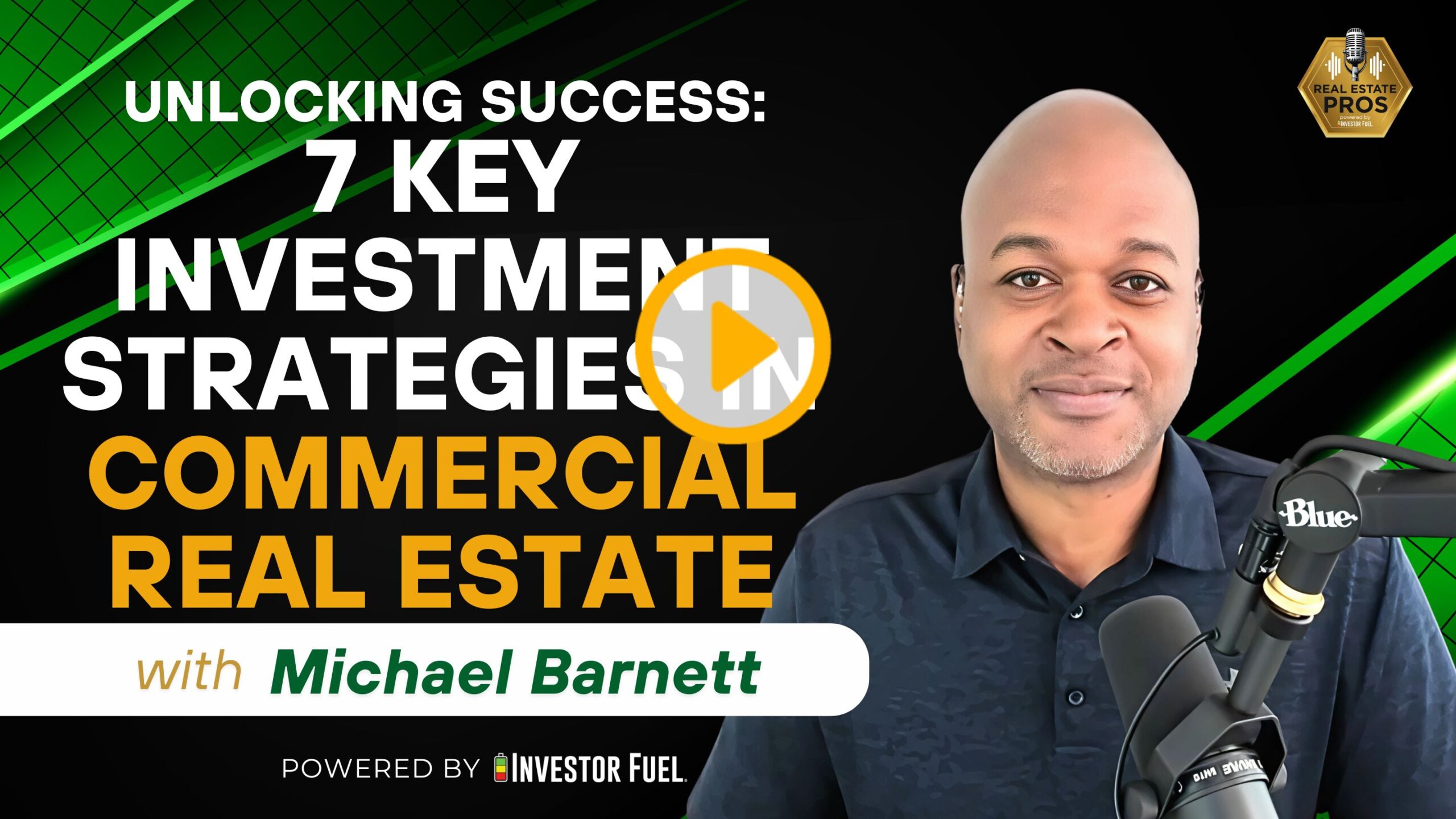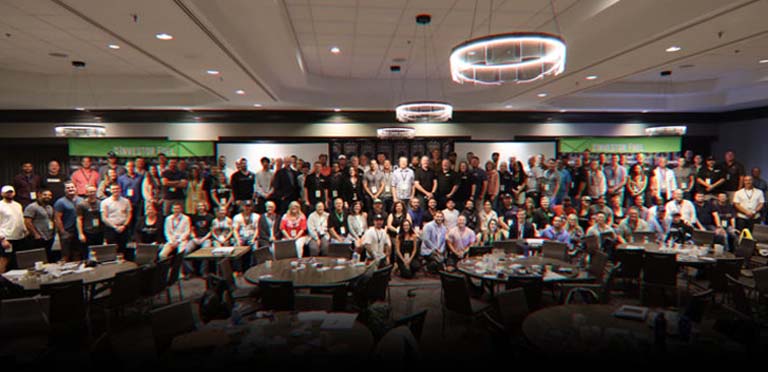
Show Summary
In this conversation, John Harcar interviews Michael Barnett, who shares his extensive journey in the real estate and lending industries. Michael discusses how he transitioned from a technology background into commercial lending, the challenges faced in the lending industry, and current trends in real estate investing. He emphasizes the importance of extracting value from real estate portfolios and shares insights on maximizing profits through innovative lending solutions. Michael concludes with key principles for success in real estate investment, highlighting resilience and the importance of not quitting too soon.
Resources and Links from this show:
Listen to the Audio Version of this Episode
Investor Fuel Show Transcript:
John Harcar (00:01.829)
All right. Hey, guys, welcome back to our show. I’m your host, John Harcar, and I’m here today with Michael Barnett. And what we’re going to talk about, besides his journey in business and in real estate, he’s going to share with us how he’s helping investors really extract the most value out of your portfolios. Guys, remember, at Investor Fuel, we help real estate investors, service providers, I mean, really all real estate entrepreneurs, 2 5X their business. We provide tools and resources to grow.
that business they want to have, which in turn helps live the life that they want to live. Michael, welcome to our show.
Michael Barnett (00:35.254)
Hey, thank you very much, John. I’m so happy and glad to be here and thanks for the invite. I really appreciate it.
John Harcar (00:40.455)
Yeah. Yeah. I’m excited to talk about, you know, extracting value. mean, every investor I know always wants more value out of their portfolios. But before we talk about that and kind of jump into the weeds of that stuff, tell us about you. Tell our audience how you got started in business and real estate and kind of what brought you up to today.
Michael Barnett (00:59.064)
Well, I really got started in real estate a very, very long time ago when I was a small child. My parents were in the real estate business. My mom used to own a ERA, real estate brokerage. My father was a residential and commercial. Yeah, I remember ERA, right? ERA back in the day. This is when they had Rolodexes, right? There were no computers. And I was the little kid that was always in…
John Harcar (01:12.355)
ERA, huh? I do, yeah.
Michael Barnett (01:24.898)
you know, sneaking in the back, stealing water out of the back as I, during the summers when I was home from school. So it was a lot of fun. but my dad was a commercial and residential building contractor. So I’d been in the like Indian and around the industry for a long time. But my first, I call it real job, right? My first real job out of college was working for this company, send that corporation at the time send that was the largest real estate and mortgage company on earth.
John Harcar (01:44.956)
Mm-hmm.
John Harcar (01:54.684)
Mm-hmm.
Michael Barnett (01:54.894)
I tell the story all the time, we were the company that made Barbara Corcoran almost a billionaire because we had purchased almost at that time, almost a billionaire when we bought Corcoran Real Estate. It was, think, a $750 million purchase at that time. But that’s where I really cut my teeth in the…
John Harcar (02:02.564)
Almost a billionaire.
Okay.
Michael Barnett (02:17.036)
real estate and mortgage business was working at Sendai Corporation, which then spun off to PHH Corporation. Again, the company that’s responsible for Caldor Banker, real estate and mortgage, Better Homes and Gardens, Sotheby’s International, et cetera, et cetera. So I had a lot of experience and exposure to all of those brands as a…
loan processor at first, then a mortgage loan originator, and then a sales coach, sales manager, executive, et cetera, for about 10 years of my life. Yeah, and then I transitioned into commercial lending, right? So I kind of, after 2000,
John Harcar (02:48.763)
walked at the ladder.
Michael Barnett (02:56.942)
We went through the 2008 crisis, right? I think we were there, right? I think you were there with me, right? The 2008 crisis, right? Maybe. Survived it. And then in 2011, I decided to leave what they call today,
John Harcar (02:59.451)
Mm-hmm. Nah, yeah, of course. I was. Can’t you tell? Yeah, well.
Got a lot in common there, Michael. Yeah, right.
Michael Barnett (03:23.95)
the Trid lending world and I decided to move into commercial lending and haven’t looked back. So since 2011, I’ve been not only originating commercial loans, but of course managing and building lending companies that deliver commercial loans.
John Harcar (03:44.455)
Awesome. You took kind of my question. like to talk. If you’ve watched any of my podcasts, I like to go backwards, right? I think there’s always so much value in a story. I usually ask folks, know, what was the first, how did you get into real estate? Were there any influences? And you took that with your parents. But my question to you would next be, okay, so you did all that with the parents, you were assimilated that way. And then you went to college. What did you study in college?
Michael Barnett (04:11.693)
computer science.
John Harcar (04:13.319)
computer science. Why is something completely different from when you got into real estate but how come you didn’t get into building or you I think you said your mom was a real estate agent?
Michael Barnett (04:14.753)
Hahaha.
Michael Barnett (04:23.433)
I mean, she was. You really want to know the story? How it all happened?
John Harcar (04:24.827)
Yeah. Well, I’m just curious because some people like when they get in, they get into what they know, right? And that’s what you were assimilated to, but you went into lending.
Michael Barnett (04:33.847)
Well, I was always a computer nerd, right? Computing and technology had always been a deep passion of mine from a small childhood. I was always really into computing technology, gaming, et cetera. And in high school, my major was computer science, computer engineering. In my high school, you were able to major in something.
John Harcar (04:59.938)
okay.
Michael Barnett (04:59.981)
And at the time it was computers back when there was a 386 and 486 computers and Microsoft, what was it? 3.1 before, before windows 95, right? So that was my major. And I always had known that I wanted to be a computer engineer or something to do in computing technology. just so worked out that after college I ended up.
John Harcar (05:09.553)
Three point, yeah. Right, right, right.
Michael Barnett (05:27.753)
in mortgage. wasn’t like it wasn’t a plan or a strategy. I would say it was good luck how I ended up in mortgage, but I still retained my passion for technology. For example, when I went to work for Sendent, I was still involved at the company in technology projects. So was involved in the development of our LOS, our load operating system. I was involved in the building, the rollout, the testing, the beta testing of that product. When I
then moved into commercial lending. I worked with our development team to build our technology, our LOS, right? And now as the founder of Lone Spark, I developed our technology because computer science is at my core and is a part of my DNA.
John Harcar (06:09.508)
Mm-hmm.
John Harcar (06:13.223)
Right. OK, awesome. So as you got into lending, mean, would assume, or mortgage, would assume maybe did any of the knowledge you’ve learned from the real estate world transition into that? it help any of that from your past?
Michael Barnett (06:27.349)
I think my mortgage lending knowledge assisted in the development of our products because we’re a financial technology company at Lone’s Park. we’re dead center in FinTech. So what I build and what we have built here are FinTech products. And I think when you are an expert in the industry,
John Harcar (06:36.817)
Got it.
Michael Barnett (06:54.593)
that you’re building products for, it really helps those products really hit the mark versus a, let’s say a software developer who’s just building a product on contract or is working for a company and is a part of a team that’s building a product but don’t really know the industry. So I think that’s one of the advantages that we have at Lone Spark is those who are building the software are experts in the industry as well.
John Harcar (07:23.441)
Are there any struggles that you come across, any challenges as you keep progressing and progressing and progressing the software or what you’re developing?
Michael Barnett (07:31.215)
There’s always challenges and I think there’s always challenges in road speed bumps. would say our biggest challenges I would say are it’s just finding great people, right? When it comes to like hiring and building the business. And I think that that’s the same challenge that a lot of our
John Harcar (07:50.855)
All right.
Michael Barnett (07:56.151)
mortgage brokerages that we partner with that they go through and mortgage companies and capital providers that we work with. It’s where things are today. It’s been just challenging just to find the best people to join the team, which is why we’re always hiring.
John Harcar (08:14.277)
Yeah. And I don’t think that’s just in the mortgage. mean, I think it’s everywhere, right? It’s always trying to find, even for a lot of our operators in our mastermind, it’s finding the right people. That’s always been a big thing. So you mentioned like with today, like what type of trends are you starting to see in the loan industry? What kind of things are starting to pop up? Or did you see foresee coming?
Michael Barnett (08:18.647)
It’s everywhere.
Michael Barnett (08:25.196)
It is.
Michael Barnett (08:36.544)
I see investor real estate transactions really coming back and coming back strong. We didn’t expect it the way that it’s occurring today. And I think there’s a couple of reasons why interest rates have come down a little bit. I think that’s one of the reasons why. But I think secondly, on the lending side,
John Harcar (08:58.705)
Mm-hmm.
Michael Barnett (09:02.466)
we are making it easier for investors to not only acquire real estate, but extract value out of that real estate. And I think it’s more of like an industry trend where as a lender and as lenders, we’re trying to make it easier for investors to buy real estate, to do so with less friction, with less red tape, with less…
with easier guidelines and making it easier for them to extract equity from their investments faster. So I think that’s one of the reasons why I think we’re seeing such a strong surge in real estate investing. Plus I think we all know there’s really never a bad time to invest in real estate because real estate always, I we used to say it always goes up, right? We used to say always, okay. Yeah, so I mean.
John Harcar (09:51.143)
That always is a little less. It continues. I’m gonna leave that always out.
Michael Barnett (09:57.07)
I won’t say always, but I would say oftentimes real estate is generally a good investment, right? Long-term, for long-term investors, that is. So.
John Harcar (10:09.735)
100%. So before we talk about our main topic of maximizing the profits, what does your business look like now? Like, what are you guys focused on? Do you have anything, you know, any new products or things that you have for investors?
Michael Barnett (10:23.415)
think one of the things that we have been really honing over the last three years is making the commercial real estate acquisition process a friction-free experience for investors. And one of the things that we specialize in is business purpose lending and commercial real estate lending to our investors and to our applicants.
And historically, acquiring commercial real estate has been a difficult process. It hasn’t been easy. When most originators or most applicants, borrowers are thinking about purchasing a piece of commercial real estate, you’re thinking, wow, the headache. I’ve got to call the bank. It’s going to take nine years just to get the loan. Like, my God, I really want to do this. And one of the things that we’ve really focused on at Loan Spark is just
John Harcar (11:11.665)
Bye.
Michael Barnett (11:23.229)
honing the process so we can just, we can make it as simple as possible. And we’ve gotten our process down over the last three years to a science where a investor who’s looking to purchase a piece of commercial property could close in three weeks on an acquisition, whether it’s a building, a multi-unit building, let’s say a 20 unit.
multifamily building or whether it’s an office space or it could be an industrial building or something in between. We’ve gotten this process down to such a science using automation, using data analytics and using other technologies including AI, which we’ve adopted over the last year into our process that
when investors are using us for their purchase and refinance acquisitions, I mean, it’s like they’re always so happy at the end of the process, because they couldn’t believe that it’s so easy. Now, is it so easy for everyone? It isn’t for everyone, because every situation is different, but overall, we’ve really honed the process to make it very simple.
John Harcar (12:32.601)
Right.
John Harcar (12:45.319)
Nice. So let’s talk about how you extract.
If I’m listening to this and I hear extracting value out of my portfolio, mean, I’m at, well, okay. How do I do it?
Michael Barnett (12:59.287)
Yeah, I think there’s two key ways. mean, when an investor is purchasing real estate, they’re doing so for one main reason, to make money, right? Whether it’s near term or long term money, okay? Whether it’s a balance sheet asset to show, like a strong balance sheet, or maybe they wanna show P &L, one or the other. We help with both, right? So one of the things that we really specialize in is,
helping our investors extract the equity out of their investments and do so at the highest possible leverage in the shortest period of time. So over the last five years, there’s a product, if you will, that’s called the BRRRR, right? Bye. Yeah, yeah.
John Harcar (13:47.079)
the bar method by rehab, rent, refinance, repeat.
Michael Barnett (13:51.682)
You know, it’s repeat, right? This is method. But it seems easy, but it’s not necessarily always that easy because lenders have restrictions on how much value and equity can be pulled out of those investments like after a certain period of time. For example, 99 % of lenders require the investor to hold that property for six to 12 months before you could…
refinance that property at full value, which in my opinion is kind of nuts. Like I bought a property, maybe I got a great deal. I purchased a property for 500,000. It was worth 750,000. I want to turn, and I got an appraisal for 750, right? But I bought it for five. Now this is a little bit of an exaggerated situation. It does happen, but it happens, it happens, right?
John Harcar (14:21.957)
for value.
John Harcar (14:40.423)
Not really. Yeah, I’ll add that a lot.
Michael Barnett (14:44.385)
But now want to turn around and I want to do a full cash out and cash that thing out at the 750. No one really does that. We can do that under many circumstances. We can take full value of that appraisal, okay, and refi at that full appraised value, which is very important to an investor because, I scored a great deal, man. Let me win. And so we found ways to…
John Harcar (15:05.467)
Yeah.
Michael Barnett (15:13.325)
make our investors win in those circumstances. So that’s one really important one. So the scenario that I just outlined would be a scenario where again, you found the property, you bought it under value. Another scenario is you purchased the property, you rehabbed it. Let’s say the rehab, you bought the property for 500, you invested 100 in the rehab. Now you have an ARV or an after repair value of 900,000. Okay. It took you
two months to complete your rehab. Now you wanna refi that property, extract the equity, and then rent the property. You weren’t looking to sell it, right? Extract the equity. Again, there’s very few who are going to enable you to refi at that $900,000 value, okay? We can, we can do that. So that’s one way that we are helping our investors extract value out of their portfolios. Another interesting…
method that we also use and this is for professional investors who have larger portfolios of real estate that are generating P &L income and it doesn’t need to be significant P &L income. Let’s say you have a you have 10 properties or 15 properties all under the same entity and they’re generating about a hundred thousand dollars of income right for you as an investor probably going to be more than that.
but let’s say $100,000 of income. What we can do is we can take that business entity and underwrite it for a business loan that’s essentially unsecured and not collateralized against the real estate. So using your real estate holdings and using the income that those holdings produce, we can provide loans against the business entity, right, that
operates those properties, which is pretty cool because then our investors can use those lines of credit to do things like a lot of different things, right? Upgrade the properties, buy more properties, in the properties, et cetera, et cetera. So it’s two key things that we do at Lone Spark that we don’t know a lot of others that do that. Our platform is pretty neat.
John Harcar (17:14.289)
Wow. Very cool.
John Harcar (17:23.279)
Whatever, buy more property.
John Harcar (17:38.587)
Why not? mean, why don’t others do that? What gives, what makes it, you know, makes you guys able to do that.
Michael Barnett (17:44.365)
Because we’re better. I think that’s the quick and dirty reason. I think we just figured it out. We just figured out how to make what we do work in the real estate industry. The LoanSpark platform doesn’t just cater to the real estate industry. Our company, a big part of what we do at LoanSpark is real estate, but we also offer other types of loans.
other than real estate. So we have the benefit of data, of kind of the data in metrics from all industries, not just the real estate industry that helps us make decisions. And I think that’s probably what would separate LoanSpark as a lender or a provider of loans.
versus a company that just focuses on real estate loans. We do more than just real estate. So there’s a big benefit to us in terms of the intelligence that we receive.
John Harcar (18:53.745)
Makes sense, makes sense. And I’d like to ask this question before we wrap it up. All of your success, right? You’ve been, it looks like you’ve climbed the ladder, you’ve done it all. You’ve been through the ups and downs. What do you think are your keys to success?
Michael Barnett (19:08.652)
I think the main key to success is resilience and not quitting, not quitting too soon. That’s what I will say. When starting something new and building something new, whether you’re just starting out as an investor, your first investment, my first investment, it didn’t go the way that I wanted, but I didn’t quit. I didn’t quit, right? My second investment, I invested in a location.
John Harcar (19:31.044)
Mine either.
Michael Barnett (19:39.087)
That probably wasn’t, I realized before the properties were complete, cause they were new construction, that they weren’t, that I probably shouldn’t be in the deal and I got out of the deal. Okay. So I think the thing is don’t, you don’t want to quit too soon. If you really believe in what you’re doing, like you gotta stay in it because it does, it takes a while sometimes.
John Harcar (19:48.487)
Mm-hmm.
John Harcar (19:54.791)
Luckily.
Michael Barnett (20:08.546)
to get to a level of success. And if you’re on the internet, you’re on social media, you’re on Instagram or Facebook or TikTok or YouTube, it seems like everybody is successful. It’s not real. Everyone is not successful out of the gate. This takes time. It takes strategy. It takes a lot of energy. It takes effort. It takes study. Speak to people. You’re gonna make mistakes and you’re gonna recover from your mistakes.
John Harcar (20:21.728)
Mm-hmm. No.
Michael Barnett (20:36.704)
as long as you continue your process. So I think for me personally, that is what’s, I think led gotten me this far is just not quitting too soon. Now, of course, the logical follow up question is, well, how do I know is it too soon? So I think, how do I know? Like, you know, like I’m going bankrupt, you know, they’re taking my car. Like, how do I know? Right.
John Harcar (20:55.271)
out.
Right, Wait, do I have wait for my wife to leave or do I to wait for my kid? What’s the tipping point? Yeah.
Michael Barnett (21:06.614)
How do I know it’s too soon? I think that’s an answer that each of us have to answer individually for ourselves.
That’s a hard one to answer, you just, yeah, you gotta stay in it.
John Harcar (21:19.527)
I’ve been I you answered it great. You did you did. Yeah. Michael, I appreciate you coming on here and sharing all this stuff. If if there’s guys out that have that are listening that maybe have a big portfolio and they want to talk to you about some of these things you you went through, how do they get in touch? What’s the best way to reach out?
Michael Barnett (21:36.236)
Hey, just go to loanspark.com. mean loanspark.com, we’re very, very easy to find.
John Harcar (21:42.791)
Perfect. And we’ll put that in the show notes if guys can’t find it, but it’s loanspark.com. Michael, thank you again for coming on here, man. I really enjoyed it. I took some good notes. Guys, I hope you did too. And we will see you on the next one. Cheers.
Michael Barnett (21:56.644)
Awesome, thank you.






